While the majority of my posts have thus far focused upon Jewish military participation in the Second World War, I want to “step back” – chronologically, and, in in terms of subject matter – and shift attention to Jewish military service in World War One: The “Great War”. Thus, this post will focus upon the British Jewish newspaper The Jewish World, a companion publication to The Jewish Chronicle.
I discovered The Jewish World by chance, in the midst of reviewing The Jewish Chronicle for information about the military service of Jewish soldiers of the British Commonwealth within both world wars.
As such, the World has proven to be an invaluable resource, albeit not in terms of “information”, but instead, in terms of images.
Founded by George L. Lyon and published in London from 1873 to 1934, The Jewish World, “filled a position of some importance in Anglo-Jewish life, publishing articles by various Zionist leaders, as well as by non-Jewish precursors of Zionism such as Henry Wentworth Monk, and Holman Hunt, the painter. It was taken over in 1913 by The Jewish Chronicle, with which it was merged in 1934.”
Though presumably edited at the same London office as the Chronicle, a review of issues of the World published between August, 1914 through late 1918 reveals the latter to have been notably different from the Chronicle in content and format, while both – presumably under the same ownership and editorial control – paralleled one another in terms of their central focus upon Jewish solidarity, unity, and Zionism. As such, both periodicals covered significant news events (both in the United Kingdom and internationally) effecting individual Jews, or Jewish communities as a whole, with the World sometimes mirroring, to greater or lesser degree, the Chronicle’s coverage of such stories.
(Digressing, the language of the Wikipedia entry for The Jewish Chronicle is quite revealing in stating that “The JC got a strong opposing voice by The Jewish Guardian, who counterbalanced the dominant Zionist propaganda of the Chronicle”. Which raises the question: Is it not anti-Zionism that has ever been, and continues with increasing fervor, irrationality, and ferocity, to be the genuine propaganda?)
Anyway…
The differences between the publications, however, are notable – at least, as viewed through a 35mm microfilm reader!
The World featured little to no (well, it seems no…) advertising, and virtually none of the plethora of brief, ostensibly mundane, but nevertheless essential notices and news items – encompassing such topics as religious education, religious ritual, holidays, charity, community service, and philanthropy – vital; central to the ongoing activity of any Jewish community, regardless of its size or location, that was typical of every issue of the Chronicle. Likewise, though the leading page of the Chronicle during the Great War sometimes carried obituaries and death notices (when I first saw this, I thought it very, very odd: “What, obituaries on a newspaper’s first page?!”), as well as new about “life cycle” events, such items appeared nowhere within in the World.
In terms of its coverage of military service of Jews in the armed forces of the British Commonwealth, the Chronicle is invaluable, featuring lists of killed, wounded, and missing, and carrying news items – sometimes, news items in great depth! – about the experiences and observations of soldiers; excerpts of soldiers’ letters from soldiers to family friends; testimonials (sometimes, understandably hagiographic) about fallen soldiers; on rare occasion early in the war, even brief items about military service of Jews in the armies of the Central Powers. In the World, such lists were absent; such stories relatively few.
(Regretfully, no American Jewish periodical seems to have covered the military service of American Jews in WW I in such a systematic and comprehensive manner as did the Chronicle for Jews of the British Commonwealth. But, that may be the subject of another post…)
In appearance and essence, one might say that – issue per issue – the “density” and sheer quantity of information in the Chronicle far exceeded that of the World, which was reflected in their main content. The World had a somewhat “lighter”, somewhat literary emphasis, rather than the comprehensive, detailed, and direct news reporting characteristic of the Chronicle. As such, the World published fiction, with such items manifesting noticeable variations in style, length, literary quality. A notable theme of such items was the challenge of maintaining Jewish belief and identity over time, individually and collectively, in the face of assimilation, acculturation, and intermarriage (yet not so much anti-Jewish persecution), amidst the unpredictable and increasingly turbulent tides of modernity, a topic penetratingly covered in Todd M. Endelman’s Radical Assimilation in English Jewish History, 1656-1945. In addition, some of the World’s content was taken from other publications, such as the American Hebrew, The Hebrew Standard, and Jewish Comment.
And one final, striking and singular difference between the Chronicle and the World… Throughout the Great War, the latter published photographs of Jewish servicemen serving in the United Kingdom’s armed forces.
Such photographs typically appeared within the two centermost pages of most any randomly selected issue, with the total number of “photos-per-issue” varying greatly from issue to issue. The photographs were typically grouped thematically. For example, some issues displayed photographs of soldiers in the Royal Engineers; sailors in the Royal Navy; soldiers in the Levant; members of the Royal Air Force; soldiers recovering from wounds in hospital; members of the French and other Allied Armies (the United States Army, not so much, if at all!); and inevitably, soldiers wounded, killed, and missing in action.
The quality of the images – as viewed and copied from 35mm microfilm (remember film?!) viewed at the New York Public Library, in the Milstein Microform Reading Room (First Floor, Room 119, to be specific) varies tremendously from issue to issue. Upon the same page within a randomly viewed issue, some images may be of excellent quality, and others? Well, not so much.
This difference in quality of the photographs is probably due to an overlapping set of factors, encompassing: 1) the quality of the original photographic print supplied to the World, 2) the quality of the printed image in the published newspaper, 3) the quality of the microfilmed image taken of the original newspaper, and finally, 4) (here’s a big one…) the reliability and optics of the 35mm microfilm reel-to-reel reader via which these images were viewed.
Having reviewed issues of the World published during 1914 through 1918, I copied many, many (many) of these images by photographing the projected microfilm image – as displayed on a microfilm reader’s viewing screen – using a 35mm digital SLR. Well, this was a few years before the NYPL replaced most of the mechanical / optical 35mm film readers with digital 35mm film viewers. (C’est la vie…)
In cases of soldiers and sailors killed in action, missing, and wounded, I was able to find corroborating information in The Jewish Chronicle, The Commonwealth War Graves Commission, the British Jewry Book of Honour, Australian Jewry’s Book of Honour, and maybe another publication or two. Or three. (Or four?) ((Or five?!))
Oh, a small caveat… While the British Jewry Book of Honour is replete with portraits of soldiers and sailors, I’ve not yet reviewed my copy to see if the photographs in the World’s 1914-1918 issues appeared in the former.
So. Below are nine images from the The Jewish World of the early twentieth century, now visible in the twenty-first: “images” evocative of a world that no longer exists; events that have ceased; people who exist only as memories … and most likely, memories of memories.
For even if the memory of man – and particularly, memories of individual men – is a fleeting thing, the past yet exists, and can never be erased.
References and Suggested Reading
The Jewish Chronicle, at Wikipedia
The Jewish World, at Jewish Virtual Library
Adler, Michael, Reverend (editor), British Jewry Book of Honour, Caxton Publishing Company, London, England, 1922
Endelman, Todd M., Radical Assimilation in English Jewish History, 1656-1945, Indiana University Press, Bloomington, In., 1990
______________________________
______________________________
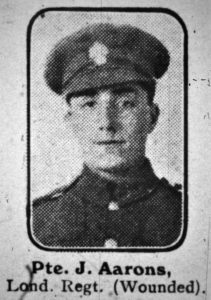 “Pte. J. Aarons, Lond. Regt. (Wounded)”
“Pte. J. Aarons, Lond. Regt. (Wounded)”
(The Jewish World, August 22, 1917)
.ת.נ.צ.ב.ה.
Private Joseph Aarons, 233751
He was killed in action of June 15, 1917
Member of London Regiment (Royal Fusiliers), 2nd / 2nd Battalion
Born in 1897
Son of Judah and Sarah Aarons, 5 Bishop’s Road, Cambridge Heath, London
Memorialized at Arras Memorial, Pas de Calais, France – Bay 9
The Jewish Chronicle: Casualty List of July 13, 1917 (incorrectly lists surname as “Aaron”)
British Jewry Book of Honour, page 76 (also lists surname as “Aaron”)
______________________________
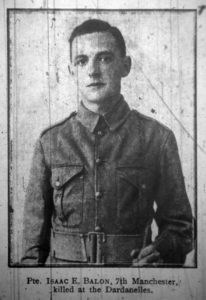 “Pte. Isaac E. Balon, 7th Manchester, killed at the Dardanelles.”
“Pte. Isaac E. Balon, 7th Manchester, killed at the Dardanelles.”
(The Jewish World, July 7, 1915)
.ת.נ.צ.ב.ה.
Private Isaac “Eric” Balon, 2403
He was killed in action on May 29, 1915
Member of Manchester Regiment, 1st / 7th Battalion, E Company
Born 1896
Son of Sophia Balon, 15 Shorncliffe Green, Whitworth Park / 91 Oxford St., Manchester
Buried at Redoubt Cemetery, Helles, Turkey – Sp. Mem. A,93
The Jewish Chronicle: Obituary Section of July 9, 1915 and May 30, 1919
British Jewry Book of Honour, page 78
______________________________
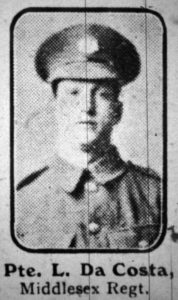 “Pte. L. Da Costa, Middlesex Regt.”
“Pte. L. Da Costa, Middlesex Regt.”
(The Jewish World, August 22, 1917)
.ת.נ.צ.ב.ה.
Private Lewis Da Costa, L/14851
He was killed in Action on August 1, 1917
Member of Middlesex Regiment, 2nd Battalion
Born 1897
Son of Isaac and Rachel Da Costa, 35 Hedson Buildings (and) 73 Walton Buildings, Shoreditch, London, E
Buried at Tyne Cot Cemetery, Zonnebeke, West-Vlaanderen, Belgium – XLVII,B,11
“Deeply Mourned by His Parents & Relatives. May His Soul Rest in Peace”
The Jewish Chronicle: Casualty List of August 17, 1917
The Jewish Chronicle: Obituary Section of August 17, 1917, and August 2, 1918
British Jewry Book of Honour, page 86
______________________________
 “Pvt. David Eckstein, Devonshire Regt., who was killed in action.”
“Pvt. David Eckstein, Devonshire Regt., who was killed in action.”
(The Jewish World, January 20, 1915)
.ת.נ.צ.ב.ה.
Private David Eckstein, Z/6943
Killed in action on December 17, 1914
Member of Devonshire Regiment, 1st Battalion
Born 1893
Mother was Eva (Eckstein) Moss (mother), 13 Providence Place, Aldgate, London
Address also 22 Collingwood St., Bethnal Green, London, E
Memorialized at Ypres (Menin Gate) Memorial, Ieper, West-Vlaanderen, Belgium – Panel 21
British Jewry Book of Honour, page 87
______________________________
 “Lieut. J.H. Levey has just received commission having risen from the ranks.”
“Lieut. J.H. Levey has just received commission having risen from the ranks.”
(The Jewish World, October 21, 1914)
This man’s name does not appear in the CWGC database; he presumably survived the war. His name is also absent from The Jewish Chronicle between August of 1914 and mid-1919.
Of all the many soldiers’ photographic portraits published in wartime issues of The Jewish World, the photo of Lieutenant Levey is among the best – if not the very best – in terms of focus, contrast, and composition, let alone quality of reproduction as a microfilmed image.
______________________________
 “Pte. Harry Myers, Lord Lovat’s Scotts.”
“Pte. Harry Myers, Lord Lovat’s Scotts.”
(The Jewish World, March 8, 1916)
Akin to Lieut. Levey, Pte. Myers’ name does not appear in the CWGC database.
During the war, The Jewish Chronicle listed the names of eight soldiers surnamed “Myers”, whose first names began with the letters “H…”, of whom four were killed, and four others wounded. However, none of these eight soldiers were recorded as having been assigned to Lord Lovat’s Scotts. Perhaps Harry (at least, this Harry Myers) survived the war?
______________________________
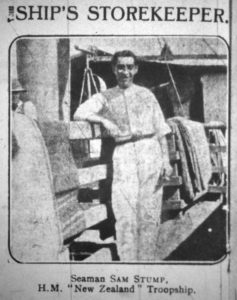 “Seaman Sam Stump, H.M. “New Zealand” Troopship.”
“Seaman Sam Stump, H.M. “New Zealand” Troopship.”
(The Jewish World, April 5, 1916)
Like Lieutenant Levey, and probably like Pte. Myers, Seaman Stump’s name does not appear at the CWGC database.
______________________________
 “Gunner A. Stern, Cape Peninsular Rifles, one of four brothers serving in the same regiment.”
“Gunner A. Stern, Cape Peninsular Rifles, one of four brothers serving in the same regiment.”
(The Jewish World, August 11, 1915)
Gunner Stern, name also absent from the CWGC database, is posed at a Vickers machine gun.
______________________________
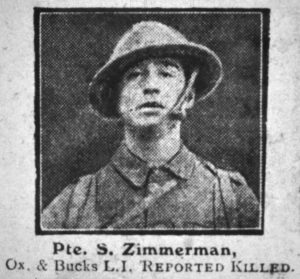 “Pte. S. Zimmerman, Ox. & Bucks L.I., Reported Killed.”
“Pte. S. Zimmerman, Ox. & Bucks L.I., Reported Killed.”
(The Jewish World, March 21, 1917)
.ת.נ.צ.ב.ה.
Private Soloman Zimmerman, 14678
Member of Oxford and Bucks Light Infantry, 5th Battalion
Killed in action August 24, 1916
Born 1897
Buried at Delville Wood Cemetery, Longueval, Somme, France – IV,I,5
On matzeva: “God Rest His Soul in Peace”
The Jewish Chronicle: Casualty List of October 13, 1916
British Jewry Book of Honour, page 124
______________________________
The image below show the casualty and award list appearing in The Jewish Chronicle of October 13, 1916, with Private Zimmerman’s name appearing last in the “Killed” section. (This image is a digitally “cleaned-up” scan of a photocopy.)
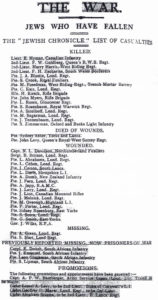 This list, only one of the sad abundance of such lists that were published in the Chronicle from late 1914 through mid-1919, is entirely representative of the presentation of information about casualties and award recipients in that newspaper. Note that while the soldiers’ surnames are presented in full, the first name is limited to only a first initial. Military service numbers are absent, though the Chronicle did include soldiers’ numbers commencing in July of 1917, while the names of the regiment (or other major organization to which the soldier was assigned) appeared throughout the war. Similarly – unfortunately! – there is absolutely no genealogical information: No next of kin; no residential address; no city or town of residence.
This list, only one of the sad abundance of such lists that were published in the Chronicle from late 1914 through mid-1919, is entirely representative of the presentation of information about casualties and award recipients in that newspaper. Note that while the soldiers’ surnames are presented in full, the first name is limited to only a first initial. Military service numbers are absent, though the Chronicle did include soldiers’ numbers commencing in July of 1917, while the names of the regiment (or other major organization to which the soldier was assigned) appeared throughout the war. Similarly – unfortunately! – there is absolutely no genealogical information: No next of kin; no residential address; no city or town of residence.
Taken as a whole, while this information is invaluable, it can sometimes be extremely challenging (if not impossible) to “disambiguate” – as the word goes – specific individuals. For example, 39 soldiers by the name of “J. Cohen” appeared in Casualty Lists in the Chronicle between 1914 and 1919.
Yet, regarding Private Soloman Zimmerman…
Alas, that he fell for his country.
Alas, once more, and yet again, that he was not the only member of his family to have so fallen. Two of his brothers – Joseph and Nathan – were also killed during the war.
Rifleman Joseph Zimmerman, C/6123, a member of the King’s Royal Rifle Corps, 16th Battalion, was killed on April 23, 1917.
Private Nathan Zimmerman, 42533, a member of the Yorkshire Regiment, 2nd Battalion, was killed on May 8, 1918.
Neither Joseph nor Nathan has a place of burial.
Joseph is memorialized at the Arras Memorial, at Pas de Calais, France (Bay 7), while Nathan is memorialized at the Tyne Cot Memorial, Zonnebeke, West-Vlaanderen, Belgium (Panel 52 to 54 and 162A). Unlike Soloman, I do not believe their names appeared in The Jewish Chronicle, though the names, first initial, and service numbers of all three brothers appear on page 124 of Reverend Michael Adler’s British Jewish Book of Honour.
The three Zimmerman brothers were the sons of Jacob (by trade a tailor) and Eva Zimmerman, of 34 Kensington Gardens, Balsall Heath Road, in Birmingham. According to the 1911 Census of England and Wales – when the family was residing at 30 Sherlock Street in Birmingham – their siblings included Israel, a tailor like his father (born 1880), Maurice (born 1882), Sarah (1885), Woolfe (1887), Abraham (1889), Rachel (1893), and David (1899). Though Soloman appears in that census, brothers Nathan and Josephs’ names are absent; for Joseph, probably because he had married Florence Moore (noted in his biographical profile at British Jews in the First World War) and likely resided elsewhere. (In the 1901 Census, Nathan is recorded as residing with his parents, the family then living at 29 Lower Essex Street in Birmingham.)
You can view the Zimmerman family’s record in the 1911 Census (from Ancestry.com) below:
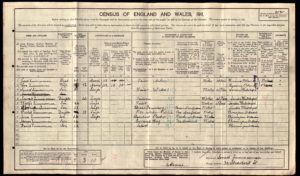 And, you can view Kensington Gardens in Birmingham, as seen in this image captured by the roving digital panopticon (otherwise known as Google Street View) from March of 2019.
And, you can view Kensington Gardens in Birmingham, as seen in this image captured by the roving digital panopticon (otherwise known as Google Street View) from March of 2019.

